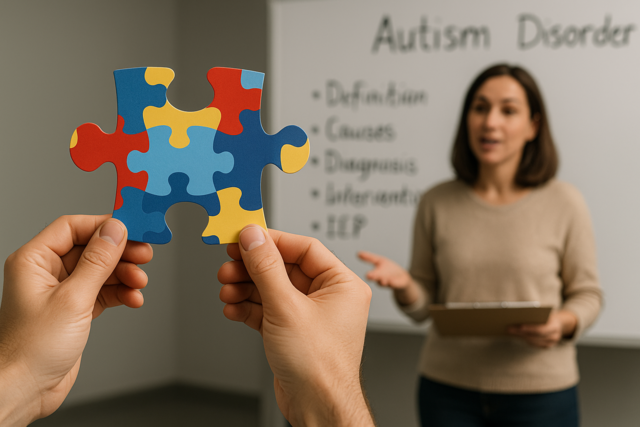Introduction
Child development is a multidisciplinary field that relies on knowledge from several other fields, such as psychology, sociology, human development, and the medical field. The study of child development is important to improve outcomes for children and, in turn, society as a whole. The following information serves as an introduction to the field, including how it is defined, its purpose for society, and how it generates knowledge and useful tools.
What is child development?
Child development may be defined as the various changes that occur for humans -- physical, cognitive, social, and emotional -- between birth and adulthood. Child development may also examine changes that occur prenatally (before birth). The changes that happen before birth and in the early years of life impact us all and shape who we become as adults. Early child development often focuses on the first five years of life.
The study of child development is often broken down into major domains of development. These include physical, cognitive and social-emotional development1. In addition, language/literacy development and identity development are often studied within child development1, 2. The chart below summarizes each of these domains.
|
Physical development |
Biological development of the human body and skills that are performed using the body |
Examples of physical development in childhood: growth of limbs, development of the brain Examples of skills performed related to physical development: learning to crawl, walk, and run |
|
Cognitive development |
Development of thinking processes that occur for human beings |
Examples of cognitive development in childhood: children performing mental reasoning and making decisions based on their reasoning |
|
Social-emotional development |
Development of the skills used to form and maintain human relationships and connectedness; development of emotional skills |
Examples of social-emotional development in childhood: babies developing the ability to self-soothe (e.g., thumb sucking); children learning to share toys with others |
|
Additional domains: |
||
|
Language & literacy development |
Development of the skills used to communicate with others through languages, as well as the ability to read and write |
Examples of language and literacy development in childhood: learning to speak the native language of one's parents; a deaf child learning sign language; a young child learning to read |
|
Identity development |
Development of one's sense of self; identity may develop around one's gender, culture, and morals |
Examples of identity development in childhood: a child learning what behaviors are considered "right" vs. "wrong" (i.e., acceptable vs. unacceptable) within their culture; a child learning what behaviors are expected based on their gender and using this knowledge to guide their actions |
Why does child development matter?
The main reason that child development is a field of study is to improve child outcomes. There are many uses for the knowledge generated from the study of child development. For one, child development knowledge can be used to inform parenting practices and optimize outcomes for individual children. For example, the study of infants generates knowledge to help parents learn what to expect during their child's first year of life and interpret infant behaviors, like crying and eye-gazing. Understanding a baby's behaviors helps parents better meet the needs of their children and improves outcomes for children.
Another use of the knowledge generated from the study of child development is to inform the practices used by child care professionals, such as child care providers, teachers, social workers, child psychologists, and pediatric doctors and nurses. For example, child development studies help define the normative physical changes that should occur for children, which enables medical and mental health professionals to detect the presence of development disabilities and disorders, like autism.
The knowledge generated from the study of child development is also used to inform public policy. Policies that affect children may operate on the micro level (e.g., local community regulations) or on the macro level (e.g., federal legislation). For example, in the U.S., federal law makers have used the results of child development studies to shape programs like Head Start3.
How is child development studied?
Child development is studied using major theories of the broader field of human development and scientific research, which are guided by these theories. The concept of "nature versus nurture," which refers to the idea that all humans are influenced by both nature-based factors (e.g., genetics) and nurture-based factors (e.g., home environment in which one is raised), is one that underlies the study of child development. The theories used in child development all vary in the degree to which they emphasize heredity versus environmental influences.
Some of the dominant theories used within child development include1:
- Psychoanalytic theory � Originated by Sigmund Freud, and advanced by Erik Erikson, this theory centers around the practice of psychoanalysis, which involves analysis of the "psyche" (mind) and uncovering deep, unconscious motives which drive people's behaviors, thoughts, and overall development throughout life
- Behavioral theory - Leading figures include John Watson and B.F. Skinner; focuses on behaviors and the acquisition of behaviors through different processes (e.g., classical conditioning, reinforcement, punishment)
- Social cognitive theory � Developed by Albert Bandura; considered a behavioral theory that focuses on the cognitive (mental) processes that interact with behavioral learning to produce behaviors (e.g., observational learning, development of self-efficacy)
- Ecological theory � Developed by Urie Bronfenbrenner; main focus is on examining human development within the environmental context; environments range from the smallest to the largest levels surrounding the individual (see figure below):
-
- Micro-system � most immediate surroundings called the microsystem (e.g., home, school, church)
- Meso-system � interaction between microsystems
- Exo-system � environments that are external to a person in that they never directly make contact with them, but which still affect the person (e.g., a parent's workplace would be within a child's exo-system)
- Macro-system � larger societal context (e.g., country, culture)
- Biological theory � may include several theories which focus on the impact of a person's biology (e.g., genetic make-up) on their behavior and development; examples include neuropsychology, which examines brain structure's influence on behavior, and behavioral genomics, which examines how genetics influence behavior
Source: University of Arizona4
Introduction
Prenatal development is the earliest stage of human development. It pertains to all of the development that occurs before birth. This stage is typically examined in two main ways -- by development stage of the fetus (three stages) and by stage of a woman's pregnancy (also three stages, but with different timing). This is a critical period of human development, as it sets the stage for lifelong development. It is one during which growth often results in the birth of a healthy baby, but also one during which many problems may arise.
When does development begin?
Prenatal development begins during fertilization. This is a process during which an egg (contained in a woman's ovary) meets with a sperm and conception begins1. An egg that has been fertilized is called a zygote1. The chances of conception of a male are higher than a female, as the ratio of male-to-female births is approximately 106 to 1001. Once fertilization occurs, the stages of prenatal development begin.
What occurs during prenatal development?
There are three stages of prenatal development: germinal, embryonic, and fetal1. During the germinal stage, which lasts from conception to two weeks, what starts out as one cell splits and multiplies as the zygote develops. At about five days post fertilization, implantation into a woman's uterine lining happens, or the zygote exits the woman's body through menstruation if the implantation fails (i.e., miscarriage). This can occur without a woman's knowledge. If implantation is successful, the zygote cells continue to replicate and grow into an embryo.
The second stage of prenatal development is the embryonic stage. This lasts from two weeks after fertilization to two months. During this time, the embryo begins growing by getting nutrients from its mother through an organ called the placenta, and the umbilical cord, which connects the mother and embryo. Organs such as the brain and heart begin to develop during this stage. Thus, although this stage is brief, it is a key period of development that has a significant impact on the health of the future baby. By the end of the embryonic stage, a fetus is about one inch long.
The final stage of prenatal development is the fetal stage. This lasts from two months to birth. During this stage, organs continue to develop and gender-specific organs (e.g., testes, ovaries) emerge, along with androgen and other gender-specific hormones. Most of this time period is spent resting, but the developing fetus also spends about five to 10 percent of its time awake and able to experience sensations, such as hearing sounds, and moving around. For example, a fetus may kick and a pregnant woman can detect such movements.
In addition to these three stages of prenatal development, there are three stages called trimesters, which refer to the pregnancy of the mother. Trimesters are measured differently than the prenatal development stage � they are each approximately three months in length totaling to approximately nine months before birth occurs. These stages help women know what to expect during their pregnancy and how to care for themselves and the growing fetus.
What problems may arise during prenatal development?
The development of a fetus is a long process and there are problems that may arise, as well as special considerations that pregnant women should take into account. Potential problems that may arise during prenatal development include miscarriage, stillbirth, and disease. To help prevent problems, a woman should take into account her diet, substance use, and stress levels. There is also the potential that infertility may prevent fertilization from taking place.
Infertility is the failure to conceive a pregnancy after approximately one year1. Infertility can occur for a number of various reasons, either related to the male or female attempting to conceive. Infertility can be addressed with treatments such as in vitro fertilization -- a medical procedure in which fertilization is performed to create an embryo, which is later implanted into a woman's uterus -- or prescribed drugs that help increase egg production.
Miscarriage is a potential problem that can occur during prenatal development. It is a common and natural occurrence in which a fetus is lost and exits the woman's body before 20 weeks of age1. Most occur due to genetic abnormalities, but they may also occur due to trauma to a woman's body.
Stillbirth is another potential problem that can happen during prenatal development. While a miscarriage is defined as occurring before 20 weeks of age, stillbirth is defined as fetal death after 20 weeks2. About one out of 160 pregnancies results in stillbirth, and most occur before a woman gives birth, while the fetus is still developing in the mother's womb2. There are various causes, including genetic abnormalities, fetal infections, and placental abruption2.
Diseases and infections may also affect prenatal development and harm a developing fetus. Possible diseases that may affect this stage of development, include sexually transmitted diseases (STDs) and HIV/AIDS1. With proper medical treatment, these conditions can be addressed such that the risk of a fetus contracting them are significantly lowered. For example, infection rates for infants of HIV-positive mothers can be dropped to less than two percent with the proper medical regimen1.
To help prevent problems during prenatal development, pregnant women should consider their diet, substance use, and stress levels. Regarding diet, proper diet is critical to development before birth. In general, pregnant women need extra calories to aid in fetal development and should gain between 25 to 35 pounds1.
Substances like drugs and alcohol should be avoided during pregnancy, as they may negatively impact prenatal development. For example, there is an increased risk for miscarriage, stillbirth, or having a baby born with fetal alcohol syndrome (FAS) for pregnant women who abuse alcohol3. Babies born with FAS may have physical abnormalities -- such as facial abnormalities and small head circumference; cognitive problems, such as difficulty learning; and behavioral problems, such as emotional difficulties1.
Finally, stress experienced by a pregnant woman can impact prenatal development through the transmission of cortisol and other stress hormones to the developing fetus. For example, stress can impact fetal growth and lower birth weight1. Therefore, controlling maternal stress is important, especially during the early stages of development.
Conclusion
Prenatal development begins at fertilization of an egg and occurs in three stages of prenatal growth: germinal, embryonic, and fetal. The embryonic stage is particularly important for the development of organs. Major problems that may occur during prenatal development include miscarriage, stillbirth, disease, or infection. To achieve optimal outcomes during this stage of development, some major considerations that pregnant women should take into account include diet, substance use, and stress management.
























